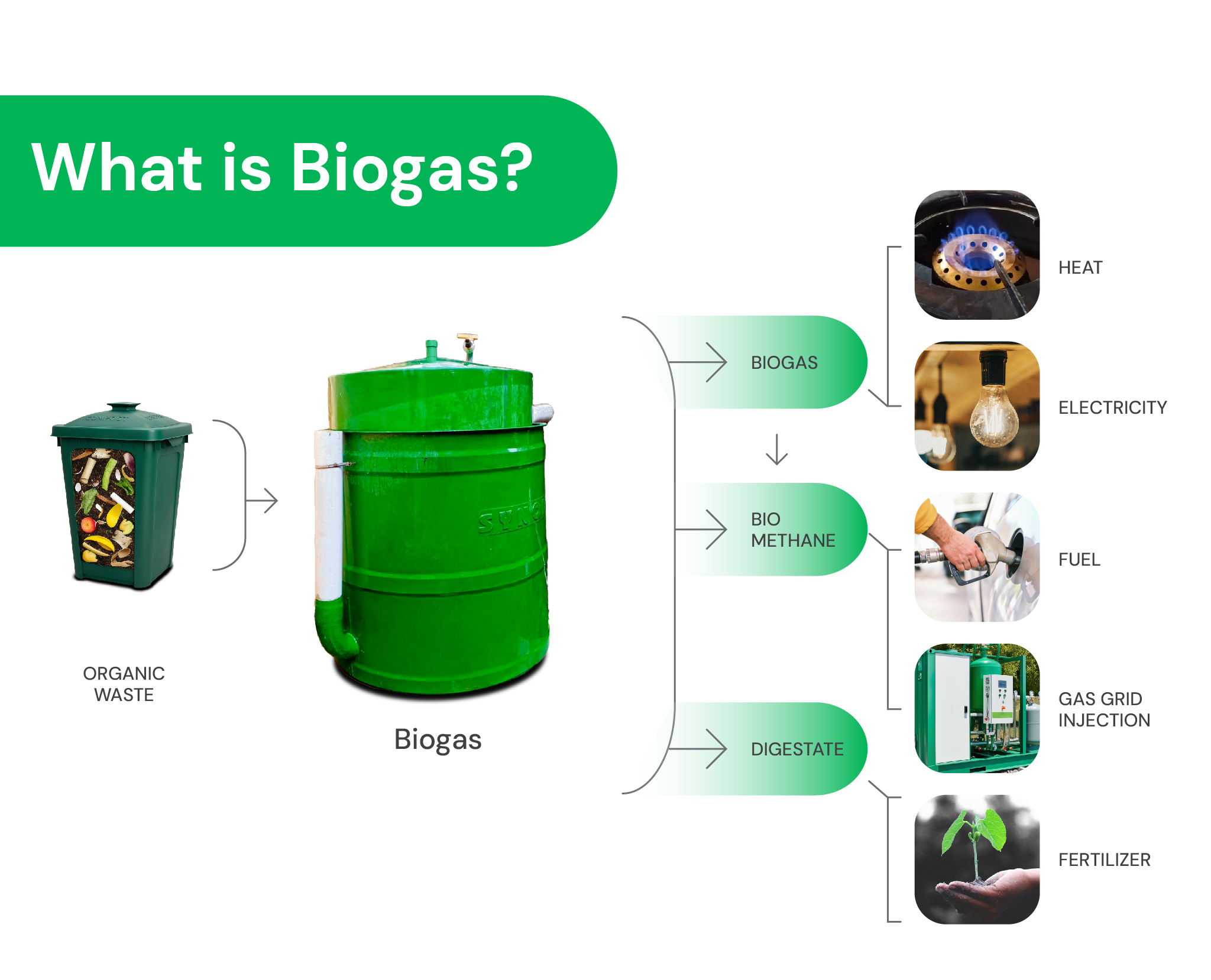Our Blogs
Biogas: The Green Energy Revolution for a Sustainable Future
Imagine turning your everyday kitchen waste into a powerful, eco-friendly fuel. Sounds like magic, right? That’s exactly what biogas does! As the world shifts toward renewable energy, biogas stands out as a sustainable and cost-effective solution for homes, businesses, and industries.
In this blog, we’ll explore what biogas is, why it’s important, its key features, how to use it, real-life case studies, and how you can be a part of this green energy revolution.
What is Biogas?
🔗Click to watch a video to understand what is Biogas
Biogas is a renewable energy source produced by decomposing organic matter such as food waste, manure, and agricultural residues in an oxygen-free environment (anaerobic digestion). The process generates a mixture of gases, primarily: Methane (CH₄), Carbon Dioxide (CO₂) and small amounts of other gases like hydrogen sulfide (H₂S) and water vapour.
This gas can be used as a cooking fuel, to generate electricity, and even as a vehicle fuel when purified into biomethane.
Features of Biogas
✅ Versatile Usage – Can be used for cooking, electricity generation, heating, and as a transport fuel.
✅ Scalable Technology – Works for households, hotels, farms, industries, and municipalities.
✅ Cost-Effective – Once set up, biogas production is low-cost and sustainable.
✅ Reduces Landfill Waste – Helps cities and villages manage organic waste efficiently.
✅ Byproduct: Organic Fertilizer – The leftover slurry is a rich organic fertilizer, enhancing soil health.
How to Use Biogas?
Biogas production occurs through a natural process called anaerobic digestion, where microorganisms break down organic waste in the absence of oxygen. Here’s a step-by-step breakdown of the process:
- 1️⃣ Waste Collection -Organic materials like food waste, animal manure, and agricultural residues are gathered.
- 2️⃣ Anaerobic Digestion -The waste is fed into a biogas digester, a sealed tank where bacteria break it down, releasing methane-rich biogas.
- 3️⃣ Gas Storage & Utilization - The produced gas is collected and stored and is most popular and widely used in cooking.
- 4️⃣ Byproduct Utilization - The leftover slurry, called digestate, is a nutrient-rich organic fertilizer that can be used for farming.
Case Studies: Biogas Success Stories
🍽 Case Study 1: Eden Restaurant’s Sustainable Transformation with Biogas
At Eden Restaurant, sustainability isn’t just a concept—it’s a way of life. Avinash, the restaurant owner, took a bold step towards eco-friendly waste management by adopting biogas technology with the help of AlterEnergyZ.
🔗 Watch the video to hear what Avinash has to say about his Biogas plant
🍽 Case Study 2: Bluebird Restaurant Vagator’s Green Initiative with Biogas
At Bluebird Restaurant, Vagator, sustainability is more than just a trend—it’s a commitment. Traditional waste management solutions were neither sustainable nor cost-effective, leading Antonio to seek an innovative alternative. Antonio, the restaurant owner, partnered with AlterEnergyZ to implement an eco-friendly biogas solution, ensuring that food waste is put to good use rather than ending up in landfills.
🔗 Watch the video to watch Antonio's sustainable transformation
Take Action: Be a Part of the Biogas Revolution!
Biogas is not just an alternative energy source—it’s the future of sustainable waste management and energy production. With benefits ranging from cost savings to environmental conservation, adopting biogas is a step toward a cleaner, greener planet.
Are you ready to power your home or business with waste? The future is renewable, and biogas is leading the way! 🌍💡♻
🌱 Contact AlterEnergyZ today to get your biogas system and take the first step towards a greener future! ♻✨





